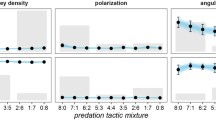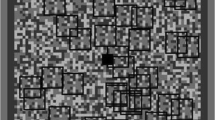Summary
Attention is drawn to the widespread occurrence ofprotean phenomena, in which the appearance and behaviour of prey animals are rendered variable and irregular, as a weapon in the biological arms race between predators and their prey. Protean behaviour is defined as that behaviour which is sufficiently unsystematic to prevent a reactor predicting in detail the position or actions of the actor.
Single prey animals frequently flee from a predator in an irregular manner, zigzagging, spinning, looping, or bouncing. Thissingle erratic display occurs widely in the Animal Kingdom, and may also be utilised in everyday movements of potential prey as insurance against possible attack. Examples are given.
In a group of prey animals the protean aspect of escape is enhanced by the effect of numbers. In scatter reactions the effect is of multiple choice and of the simultaneous operation of several single erratics. In mobbing displays there are also successive changes in the actors' behavioural role. In protean deterrence the shuffling of individuals within a tightly packed group prevents a predator from singling one out for attack.
In many species the confusing effect of changes in movement and behavioural role is enhanced by rapid changes in appearance, particularly colour.
It is suggested that those prey individuals which employ escape patterns unfamiliar to the predator will tend to be at a selective advantage. During phylogeny this is likely to lead to intra-specific and inter-specific increase in the number and diversity of escape behaviours. Apostatic polymorphism is seen as a special case of protean variation within populations.
There is evidence that protean displays operate by arousing neurological conflict, thereby delaying the predator's reactions and reducing the effectiveness of predatory mechanisms. Also they insure against learned countermeasures by incorporating irregularities as a basic principle. It is stressed that the irregular variability of protean displays is not accidental but has been selected for in phylogeny. A number of poorly understood behavioural aspects of the ecology of predator-prey relationships are thus united in a single theory.
Similar content being viewed by others
References
Armstrong, E. A.: Bird display and behaviour. London: Lindsey Press 1947.
—: Diversionary display. Fart I. Connotation and terminology. Part II. The nature and origin of distraction display. Ibis91, 88–97, 179–188 (1949).
—: The ecology of distraction display. Brit. J. Anim. Behav.2, 121–135 (1954).
Audubon, J. J.: Birds of America. New York: Macmillan 1950.
Baerends, G. P.: Specializations in organs and movements with a releasing function. Symp. Soc. exp. Biol.4, 337–360 (1950).
Bergman, G.: Om simfalgars och vadares hackning i masfagelkolonier. Dansk orn. Foren. Tidsskr.35, 120–123 (1941).
Berlyne, D. E.: Conflict, arousal and curiosity. London: McGraw-Hill 1960.
Beukema, J. J.: Predation by the three-spined sticklebach (Gasterosteus aculeatus L.): The influence of hunger and experience. Behaviour31, 1–126 (1968).
Blest, A. D.: The function of eyespot patterns in the Lepidoptera. Behaviour11, 209–255 (1957a).
—: The evolution of protective displays in the Saturnioidea and Sphingidae (Lepidoptera). Behaviour11, 257–309 (1957b).
—: Protective display and sound production in some New World aretiid and ctenuchid moths. Zoologica49, 161–181 (1964).
Bowen, E. S.: The role of the sense organs in aggregations ofAmeiurus melas. Ecol. Monogr.1, 1–35 (1931).
Boycott, B. B.: A comparison of livingSepioteuthis sepioidea andDoryteuthis plei with other squids and withSepia officinalis. Proc. zool. Soc. Lond.147, 344–351 (1965).
Bristowe, W. S.: The world of spiders. London: Collins 1958.
Brower, L. P.: Ecological chemistry. Scient. Amer.220 (2), 22–29 (1969).
Bullock, T. H.: Evolution of neurophysiological mechanisms. Behaviour and evolution. New Haven: Yale University Press 1958.
Chance, M. R. A.: The role of convulsions in behaviour. Behav. Sci.2, 30–45 (1957).
Chance, M. R. A.: Polyethism — cryptic behaviour. Proc. 5th internat. Congr. Zool. Section11 (1) (1959).
—, Russell, W. M. S.: Protean displays: a form of allaesthetic behaviour. Proc. zool. Soc. Lond.132, 65–70 (1959).
—, Yaxley, D. C.: New aspects of the behaviour ofPeromyscus under audiogenic hyper-excitement. Behaviour2, 96–105 (1949).
Clarke, B. C.: Balanced polymorphism and the diversity of sympatric species. Taxonomy and geography. London: Systematics Association 1962a.
—: Natural selection in mixed populations of two polymorphic snails. Heredity (Lond.)17, 319–345 (1962b).
Cott, H. B.: Adaptive coloration in animals. London: Methuen 1940.
Denton, E. J., Nicol, J. A. C.: Why fish have silvery sides: a method of measuring reflectivity. J. Physiol. (Lond.)165, 13–15 (1962).
Driver, P. M.: Behaviour studies in sea ducklings. Ph. D. Thesis, McGill University, Montreal 1960.
—, Humphries, D. A.: Protean behaviour; systematic unpredictability in interspecific encounters. Preprint 197, Mental Health Research Institute, Ann Arbor 1966.
—: The significance of the high-intensity alarm call in captured passerines. Ibis111, 243–244 (1969).
—: Protean displays as conflict inducers. Nature (Lond.)226, 968–969 (1970).
Dunning, D. C., Roeder, K. D.: Moth sounds and insect-catching behaviour of bats. Science147, 173–174 (1965).
Gurney, J. H.: On some additional species of birds received in collections from Natal. Ibis12, 132 (1861).
Hemmings, C. C.: Factors influencing the visibility of objects underwater. Symposium on light as an ecological factor, p. 359–374. Oxford: Blackwell 1966.
Hinde, R. A.: Factors governing the changes in strength of a partially inborn response, as shown by the mobbing behaviour of the chaffinch,Fringilla coelebs. Proc. roy. Soc. B142, 306–358 (1954).
Holmes, W.: The colour changes and colour patterns ofSepia officinalis L. Proc. zool. Soc. Lond.110, 17–35 (1940).
Howard, L. O.: The insect book. New York: Doubleday and Page 1901.
Humphries, D. A.: Erratic movement and a cataleptic posture in the escape behaviour of fleas. Entomologist's mon. Mag. (in press).
—, Driver, P. M.: Erratic display as a device against predators. Science156, 1767–1768 (1967).
Kennedy, J. S., Booth, C. O.: Free flight of aphids in the laboratory. J. exp. Biol.40, 67–85 (1963).
Kruuk, H.: Predators and anti-predator behaviour of the black-headed gull (Larus ridibundus L.). Behaviour, Suppl.11, 1–129 (1964).
Leyhausen, P.: Verhaltensstudien an Katzen. Z. Tierpsychol., Suppl.2 (1956).
Lind, H.: Studies on the behaviour of the black-tailed godwit (Limosa limosa L.). Meddelelser fra Naturfrednings rådets reservatudvalg. 66 (1961).
Markgren, M.: Fugitive reactions in avian behaviour. Acta vertebr.2, 1–160 (1960).
Marler, P.: Behaviour of the chaffinchFringilla coelebs. Behaviour, Suppl.5 (1956).
Marshall, S. M., Orr, A. P.: The biology of a marine copepod,Calanus finmarchicus (Gunnerus). Edinburgh: Oliver and Boyd 1955.
Meinertzhagen, R.: Pirates and predators: habits of birds. Edinburgh: Oliver and Boyd 1959.
Millais, J. G.: British diving ducks. London: Longmans 1913.
Nicol, J. A. C.: The biology of marine animals. London: Pitman 1960.
Owen, D. F.: Density effects in polymorphic land snails. Heredity (Lond.)20, 312–315 (1965).
—: The interpretation of polymorphism in the African bush-shrikes. Ibis109, 278–279 (1967).
—, Wiegert, R. G.: Balanced polymorphism in the meadow spittlebug,Philaenus spumarius. Amer. Nat.96, 353–359 (1962).
Panceri, P.: The luminous organs and light of the Pennatulae. Quart. J. micr. Sci.12, 248–254 (1872).
Payne, R. B.: Interspecific communication signals in parasitic birds. Amer. Nat.101, 363–375 (1967).
Rapoport, A.: The use and misuse of game theory. Scient. Amer.207, 108–118 (1962).
Roeder, K. D.: The behaviour of free flying moths in the presence of artificial ultrasonic pulses. Anim. Behav.10, 300–304 (1962).
Roeder, K. D., Treat, A. E.: The acoustic detection of bats by moths. Proc. 11th intern. Ent. Congr. (1960).
——: The detection and evasion of bats by moths. Amer. Scient.49, 135–148 (1961).
Ruiter, L. de: Some experiments on the camouflage of stick caterpillars. Behaviour4, 222–232 (1952).
Simmons, K. E. L.: The nature of the predator — reactions of waders towards humans; with special reference to the role of the aggressive —, escape —, and brooding drives. Behaviour8, 130–173 (1955).
Spencer, K. G.: The lapwing in Britain. London: Brown 1953.
Spooner, G. M.: Some observations on schooling in fish. J. mar. biol. Ass. U.K.17, 421–448 (1931).
Tinbergen, N.: The study of instinct. Oxford: Clarendon Press 1951.
—: Bullfinch escaping from cat by “playing dead”. Br. Birds55, 420 (1962).
—, Impekoven, N., Franck, D.: An experiment on spacing-out as a defence against predation. Behaviour28, 307–321 (1967).
Tuck, L. M.: The murres. Ottawa: Duhamel 1960.
Webster, F. A., Griffin, D. R.: The role of flight membranes in insect capture by bats. Anim. Behav.10, 332–340 (1962).
Welty, J. C.: Experiments in group behaviour of fishes. Physiol. Zool.7, 85–128 (1934).
Witherby, H. G., Jourdain, F. C. R., Ticehurst, N. F., Tucker, B. W.: The handbook of British birds. London: Witherby 1947.
Author information
Authors and Affiliations
Rights and permissions
About this article
Cite this article
Humphries, D.A., Driver, P.M. Protean defence by prey animals. Oecologia 5, 285–302 (1970). https://doi.org/10.1007/BF00815496
Received:
Issue Date:
DOI: https://doi.org/10.1007/BF00815496




